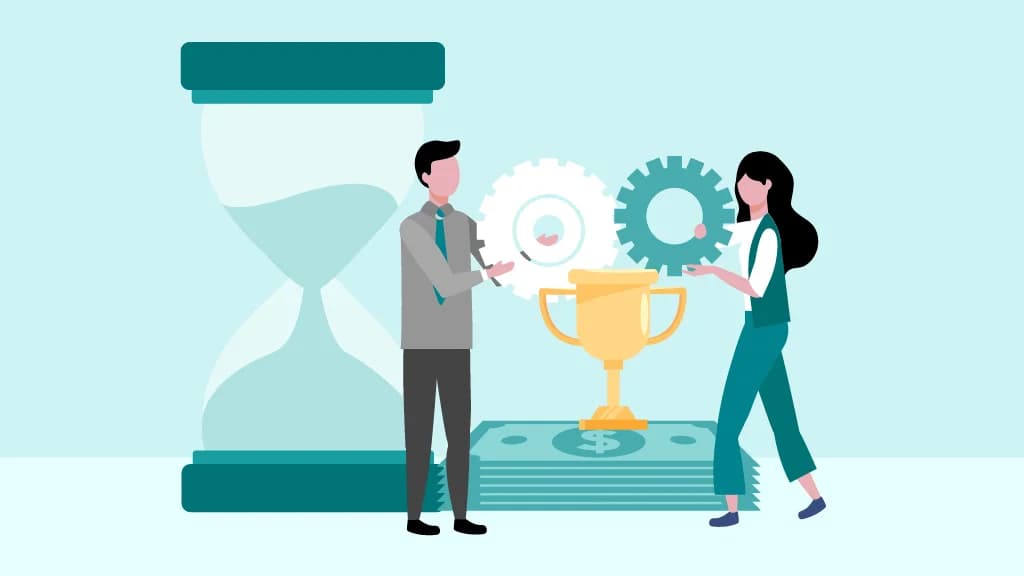
Team AdvantageClub.ai
September 30, 2025

Employee reward systems have become essential tools for organizations seeking to motivate, engage, and retain top talent. From traditional employee reward systems to modern employee point system rewards, these programs create structured approaches to recognizing and incentivizing performance.
Organizations nowadays recognize that promoting mutual respect between employers and employees is essential to establishing a long-lasting workplace and is no longer optional. People’s confidence rises, their ideas blossom, and they are more open to taking on new tasks when they truly feel valued. In other words, the right employee reward system is not just a nice-to-have—it’s a win-win that strengthens both individuals and the organization as a whole.
This comprehensive guide explores various employee reward systems, including employee points reward system examples, reward system in organization implementation, and proven reward system for employees and motivation strategies. Discover how effective employee reward point systems transform workplace culture and drive business results.
Employee reward system: Basics
What is an Employee reward system?
The employee reward system is a crucial instrument management may use to direct employee motivation in desirable directions. In other words, reward systems are designed to get individuals to join the company, retain them, and encourage them to perform well.
What are the components of a reward system?
A strategic approach to a well-balanced reward system focuses on the three main components
a. Compensation
b. Benefits
c. Recognition
Employee Reward Systems: Types and Examples
There is no one-size-fits-all approach to modern employee reward system. To maintain employee engagement, organizations today deploy a combination of monetary incentives, fulfilling experiences, and creative employee point systems. Companies can develop an organizational reward system that promotes motivation, loyalty, and long-term success by providing a balance of these strategies.
Monetary Employee Reward Systems
Since money has always been a powerful motivator, it continues to be a mainstay of the majority of employee rewards programs. These rewards recognize contributions with financial incentives that directly impact employees’ lives and give them a tangible sense of appreciation.
Examples of Monetary Employee Reward Systems include:
- Performance-based bonuses and incentives – Rewards linked to results encourage employees to aim higher consistently.
- Profit-sharing and stock option programs – Allowing employees to share in the company’s success builds long-term commitment.
- Salary increases and merit raises – Recognizing consistent contributions through permanent compensation growth.
- Commission structures for sales teams – Rewarding individual achievements while driving business outcomes.
- Spot awards for immediate recognition – Instant financial rewards that celebrate quick wins and achievements.
Non-Monetary Employee Reward Systems
Many organizations are finding that non-monetary recognition often carries just as much—if not more—value. These rewards create personal and professional fulfillment, often leaving a lasting impact on morale and motivation.
Examples of Non-Monetary Employee Reward Systems include:
- Public recognition and appreciation ceremonies – Acknowledging accomplishments in front of peers builds pride and belonging.
- Flexible work arrangements and remote options – Empowering employees with autonomy over when and where they work.
- Professional development and training opportunities – Investing in skills shows employees that growth is valued.
- Career advancement and mentorship programs – Helping employees progress in their careers while deepening engagement.
- Special privileges and exclusive experiences – From VIP parking spots to team retreats, unique perks go a long way.
Employee Point System Rewards: How They Work
Employee reward point systems have quickly become one of the most effective ways to recognize and motivate a diverse workforce. By enabling employees to accrue and use points in ways that are meaningful to them, the reward system provides flexibility and equity.
How Employee Point System Rewards Work:
- Employees earn points for specific achievements, milestones, or positive behaviors.
- Points are collected in individual accounts with transparent tracking.
- A rewards catalog gives employees the freedom to choose—whether it’s gift cards, experiences, or merchandise.
- Real-time point allocation provides instant recognition without delays.
- Gamification features like leaderboards or badges add an element of fun and engagement.
Hybrid Employee Reward Systems
For many organizations, the best approach is a combination. Employee reward point systems, non-monetary recognition, and monetary benefits are all combined in hybrid employee reward systems to provide a holistic approach. This adaptability means that each employee feels appreciated in the ways that are most relevant to them.
Examples of Hybrid Reward Systems in Organization include:
- Base salaries with layered point-based recognition for daily wins.
- Peer-to-peer recognition systems combined with tangible reward options.
- Team-based rewards that complement individual incentives.
- Short-term perks, such as gift vouchers, are paired with long-term benefits like retirement plans or profit-sharing.
By mixing these approaches, organizations can design employee rewards systems that are both inclusive and impactful, ensuring recognition resonates with every member of the workforce.
Key features of an Employee reward system
Peer-to-peer recognition
Peer-to-peer recognition is an efficient method of recognizing your employees. Employees are overjoyed when their co-workers recognize their efforts. When employees feel valued by their peers, their performance improves, and productivity rises. A reward system that allows employees to recognize and nominate their peers for monetary rewards improves company culture, cultivates a sense of belonging, and helps build strong teams.
Performance management
A performance-based reward system assesses employees on how they add value to a task and accomplish it. The rewards focus on their performance and contribution to the company, so employees feel motivated and driven to perform better.
Rewards points
Employees earn points for completing tasks and meeting objectives in a point-based reward system. These points are redeemable for a gift, a day off, or another benefit, and because they have monetary value, employees are ecstatic when they receive them. The point-based reward system is transparent and effective because managers can specify the types of events for which employees should receive reward points and monitor their employees’ performance. As the reward is received in points, it allows easy currency conversion. The system is practical for organizations with a global workforce.
Social recognition
Non-monetary employee recognition and reward system are known as social recognition. It is easy to kickstart the social recognition program. Start with a simple message of gratitude and appreciation during staff meetings. The system allows employees to feel valued for their efforts. The social recognition program is significant because it improves employee retention, morale, and engagement and positively impacts the company.
Feedback loop
Feedback is essential for improving, adjusting, or maintaining the recognition and reward programs. Evidently, employees who are given the opportunity to provide feedback are more likely to be excited about the program and engage wholeheartedly. Feedback is the most effective way to ensure that the program is received positively and especially to ensure that all challenges are overcome. Involving employees in the feedback loop is an excellent way to build rapport and foster a culture where people feel comfortable giving and receiving feedback.
Flexibility of choice
A vital feature of a successful rewards platform is that it is tailored to the organization’s values and responsive to changing employee needs. One of the practical benefits of a modern employee reward system is that it allows employees to choose their rewards. The reward point system works best when the employees can redeem vouchers and gift cards for things of their choice. Providing reward flexibility is one way of keeping the hybrid workforce motivated and engaged.
Cloud-based system
Cloud-based systems have become a necessity for all organizations now. Evidently, some features of a cloud-based reward and recognition system are seamless integration, scalability, flexibility, real-time reporting, and reward tracking. Users can access the employee recognition platform from any device using the system. This adaptability allows you to deliver information and functionality to your global workforce. Additionally, cloud-based reward and recognition platforms are simple to set up. So, you can get full customization to meet your specific requirements.
Reward System in Organization: Implementation Guide
Phase 1: Reward System Planning and Design
Define Employee Reward System Objectives:
- Identify the exact employee behaviors you want to encourage—such as collaboration, innovation, or customer service.
- Set clear, measurable goals to track the impact of employee reward systems over time.
- Allocate a realistic budget that balances meaningful rewards with sustainable costs.
- Decide whether your organization needs a monetary setup, an employee reward point system, or a hybrid that blends both approaches.
Design Reward System Framework:
- Outline simple, transparent criteria so employees understand how to earn rewards and recognition.
- Build a fair structure for point values and redemption options in employee point system rewards.
- Choose diverse reward categories and partner with trusted vendors for vouchers, experiences, or benefits.
- Put approval steps and admin workflows in place to ensure smooth and consistent management.
Phase 2: Technology and Platform Selection
Employee Reward Point System Features:
- Use AI-powered platforms to track performance and highlight key recognition moments instantly.
- Give employees real-time visibility into their point balances and achievements.
- Ensure the platform is mobile-friendly so employees can participate anytime, anywhere.
- Integrate the reward system with existing HR tools for seamless operations.
- Leverage dashboards and reports to monitor engagement and program success.
Cloud-Based System Benefits:
- Scale your employee rewards systems easily as your organization grows.
- Provide remote and hybrid teams with access to recognition tools from anywhere.
- Benefit from automatic updates, ensuring your platform always runs smoothly.
- Protect employee data with strong security and backup features.
- Keep implementation and management cost-effective without compromising on quality.
Phase 3: Launch and Communication Strategy
Employee Reward System Communication:
- Clearly explain how employees can earn and redeem rewards so there’s no confusion.
- Train managers to administer rewards fairly and encourage recognition at every level.
- Run internal campaigns—emails, posters, or town halls—to create excitement before launch.
- Share regular updates, celebrating success stories that show the program’s value.
- Encourage continuous feedback to fine-tune employee rewards systems and keep them engaging.
Phase 4: Measurement and Optimization
Key Performance Indicators for Employee Reward Systems:
- Track participation rates to see how many employees are engaging with the program.
- Monitor employee engagement scores and satisfaction surveys for cultural impact.
- Measure retention rates and reductions in turnover to assess long-term success
- Evaluate productivity and performance metrics to link rewards with results.
- Review ROI by comparing reward system costs with measurable business gains.
Employee Reward System Examples: Real-World Success Stories
Every organization has its own culture and goals, which is why employee reward systems look different across industries. From employee point system rewards to traditional recognition practices, the most effective programs are tailored to what motivates people. Let’s look at some detailed examples that show how companies are putting reward systems for employees into action.
Employee Reward System Examples That Drive Results
Technology Company Point System
A leading tech firm built an employee reward point system that keeps performance exciting and collaborative. Each employee earns 100 points monthly for meeting individual performance goals, while peer nominations add 50 bonus points for teamwork and knowledge sharing. These points can be redeemed for popular tech gadgets, versatile gift cards, or even extra paid time off. To keep motivation high, the company introduced quarterly point multipliers—employees achieving stretch goals see their points doubled, making recognition immediate and impactful.
Healthcare Organization Rewards Program
In healthcare, patient outcomes and safety are everything. One hospital group implemented an employee point system reward program tied directly to these priorities. High patient satisfaction scores trigger automatic point awards for frontline staff, while consistent safety compliance earns monthly bonuses. Employees can redeem their points for wellness perks, gym memberships, or family-friendly experiences. To build stronger teams, group challenges multiply individual points, encouraging staff to collaborate across departments to improve both patient care and workplace morale.
Traditional Employee Reward Systems Examples
Manufacturing Company Performance System
A global manufacturing company took a traditional approach by connecting rewards directly to performance metrics. Within 90 days of rolling out customized incentive programs, sales surged by 89%. Production staff earned bonuses for meeting quality and efficiency benchmarks, while safety milestones were celebrated with monetary rewards and recognition ceremonies. Long-serving employees received increasing benefit packages, reinforcing loyalty and reducing turnover in a competitive labor market.
Professional Services Recognition Program
For a professional services firm, recognition had to be fast and flexible. By modernizing their employee rewards systems with both desktop and mobile access, participation increased by 25% on computers and an incredible 146% on mobile devices. Consultants earned client satisfaction bonuses when delivering exceptional results, while knowledge-sharing rewards encouraged employees to lead training sessions. Leadership development programs were also offered as recognition rewards, showing employees that career growth itself is a valuable form of recognition.
Employee Points Reward System Examples and Best Practices
Retail Employee Point Systems
In the retail sector, where customer experience drives success, a major retailer designed an employee reward point system to keep service levels high. In addition to 500-point bonuses for reaching sales targets, associates receive 25 points for each favorable customer review. Team collaboration is rewarded, too, employees who help other departments receive points for cross-functional support. Training completion is recognized instantly, with immediate point deposits, creating a culture where learning and development are continuously valued.
Remote Team Reward Systems
Recognition for remote teams spread across multiple time zones has to feel both personal and accessible. Cloud-based employee point system rewards are now being used by businesses to streamline recognition. Participation points are awarded for virtual coffee talks, and digital badges and point deposits are awarded for finishing online courses. Bonuses are also given to staff members who participate in wellness initiatives or work across time zones. By embedding recognition into digital platforms, these organizations are proving that a reward system in organization can be just as engaging for remote teams as it is in the office.
These real-world employee reward system examples show how flexible and impactful recognition can be when it’s tied to company values, employee needs, and industry priorities.
Modern Employee Reward Systems: Technology and Trends 2025
Workplaces and employee reward systems are continuously evolving. In 2025, organizations are moving beyond one-size-fits-all perks to adopt smarter, more digital, and highly personalized approaches.
Digital Transformation of Reward Systems for Employees
Manual procedures and periodic bonuses are no longer the only ways to reward employees. Businesses are embracing digital platforms that facilitate easy and universal recognition. These technologies guarantee that employee reward programs have a greater impact than before by bringing ease, transparency, and real-time engagement.
Technology-Enabled Features:
- Automated point allocation that tracks performance and instantly rewards employees for meeting goals.
- AI-powered reward recommendations tailored to individual preferences, ensuring recognition feels personal.
- Mobile apps that allow employees to redeem rewards and celebrate achievements on the go.
- Social recognition feeds where peers can appreciate one another publicly, building a culture of appreciation.
- Real-time analytics that help leaders measure impact and continuously optimize employee rewards systems.
Personalized Employee Point System Rewards
One of the strongest trends shaping 2025 is personalization. Employees want rewards that reflect their preferences and lifestyles, not generic benefits. Personalized employee point system rewards give people the freedom to choose what matters most to them while still aligning with organizational goals.
Employee Reward Point System: Setup and Management
- Creating individual reward preference profiles that guide tailored recommendations.
- Designing custom point-earning opportunities linked to specific roles or projects.
- Offering flexible catalogs where employees can redeem points for anything from experiences to gift cards.
- Localizing reward options for global teams so employees feel recognized in ways that resonate culturally.
- Adjusting point values based on regional cost-of-living differences, making the employee reward point system fair and inclusive.
Gamification in Employee Reward Systems
Gamification is revolutionizing employee motivation within organizations. By combining recognition with enjoyable, interactive elements, organizations can maintain high engagement levels while promoting healthy competition and teamwork. Contemporary platforms are adding AI-driven gamification aspects to make recognition fun and efficient. Gamification Elements:
- Achievement badges and milestone celebrations that highlight progress in a fun, visible way.
- Leaderboards to spark friendly competition and keep employees motivated.
- Quest-style challenges where employees unlock progressive rewards by completing tasks.
- Team competitions that encourage collaboration while boosting collective point earning.
- Level progression systems that unlock access to greater rewards as employees advance.
The future of employee reward systems is digital, personalized, and gamified. By adopting these trends, organizations can create a reward system in organization that not only motivates employees but also builds a stronger, more connected culture.
Frequently Asked Questions About Employee Reward Systems
Q. What is an employee reward system?
An employee reward system is a structured way for organizations to recognize and appreciate their people. It can include monetary rewards, public recognition, employee rewards systems like benefits packages, or even an employee reward point system. At its core, it’s about creating a fair and motivating framework that acknowledges contributions and drives performance.
Q. How do employee point system rewards work?
Employee point system rewards let employees earn points for specific actions—such as hitting performance targets, collaborating with peers, or celebrating milestones. The points can then be redeemed for meaningful rewards like vouchers, merchandise, or extra time off. Common employee points reward system examples include peer-nominated points, milestone points for service anniversaries, and performance-based achievements.
Q. What are examples of reward systems in organization?
Examples of a reward system in organization range from classic bonuses and employee of the month awards to modern employee reward point systems with digital catalogs. Other examples include profit-sharing, peer-to-peer recognition, flexible schedules, learning opportunities, and tailored employee reward systems that match company culture and values.
Q. How do reward systems improve employee motivation?
When designed thoughtfully, reward systems for employees do much more than hand out perks. They motivate by recognizing real achievements, setting clear expectations, and offering meaningful incentives. They also build emotional connections between employees and the organization, creating a sense of fairness, belonging, and loyalty that drives people to give their best.
Q. What makes an effective employee reward point system?
An effective employee reward point system is simple, fair, and engaging. It has clear criteria for earning points, offers diverse redemption options, and uses transparent tracking so employees always know where they stand. When paired with easy-to-use technology and aligned with company values, these employee point system rewards become a powerful tool for sustaining motivation and performance.
Building Successful Employee Reward Systems for the Future
Employee reward systems have come a long way from being just about bonuses or perks. Today, they’re powerful strategies designed to recognize diverse motivations, connect employees with a sense of purpose, and build lasting engagement. Whether you’re setting up a traditional reward system in organization or rolling out modern employee point system rewards, success comes from thoughtful planning, clear communication, and consistent improvement.
The most effective employee rewards systems bring together meaningful recognition, tangible benefits, transparent processes, and smart technology. By looking at employee reward system examples and adapting proven employee points reward system examples to your workplace culture, companies can create programs that spark loyalty and improve performance.
As expectations shift, employee reward point systems stand out because they offer flexibility, personalization, and scalability, qualities that older approaches often lack. The key is knowing what truly motivates your workforce, setting clear reward systems for employees and motivation goals, and tracking results to ensure progress.
Organizations that invest in well-designed employee reward systems gain more than just satisfied employees, they earn stronger performance, higher retention, and a lasting competitive edge. Start by defining your goals, align rewards with company values, and build a culture where recognition and appreciation are part of everyday work.
Ready to transform your workplace? Implement employee reward system strategies that motivate employees, boost performance, and create long-term organizational value.





